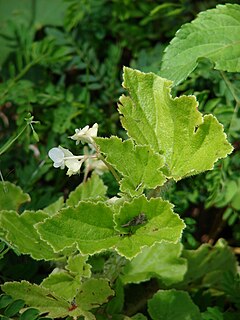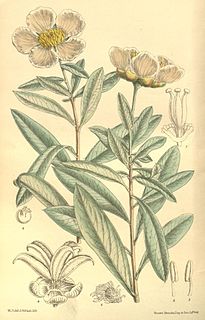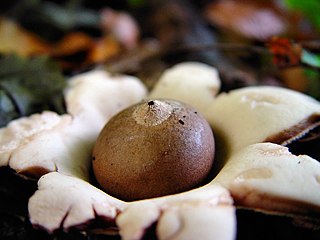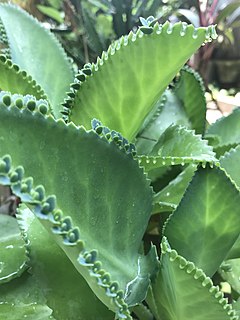
Vascular plants, also known as Tracheophyta, form a large group of plants that are defined as land plants with lignified tissues for conducting water and minerals throughout the plant. They also have a specialized non-lignified tissue to conduct products of photosynthesis. Vascular plants include the clubmosses, horsetails, ferns, gymnosperms and angiosperms. Scientific names for the group include Tracheophyta, Tracheobionta and Equisetopsida sensu lato. Some early land plants had less developed vascular tissue; the term eutracheophyte has been used for all other vascular plants.

Hypericaceae is a plant family in the order Malpighiales, comprising six to nine genera and up to 700 species, and commonly known as the St. John’s wort family. Members are found throughout the world apart from extremely cold or dry habitats. Hypericum and Triadenum occur in temperate regions but other genera are mostly tropical.

Malpighiaceae is a family of flowering plants in the order Malpighiales. It comprises about 73 genera and 1315 species, all of which are native to the tropics and subtropics. About 80% of the genera and 90% of the species occur in the New World and the rest in the Old World.

Pteridaceae is a family of ferns in the order Polypodiales, including some 1150 known species in ca 45 genera, divided over five subfamilies. The family includes four groups of genera that are sometimes recognized as separate families: the adiantoid, cheilanthoid, pteridoid, and hemionitidoid ferns. Relationships among these groups remain unclear, and although some recent genetic analyses of the Pteridales suggest that neither the family Pteridaceae nor the major groups within it are all monophyletic, as yet these analyses are insufficiently comprehensive and robust to provide good support for a revision of the order at the family level.

Begoniaceae is a family of flowering plants with two genera and about 1825 species occurring in the subtropics and tropics of both the New World and Old World. All but one of the species are in the genus Begonia. There have been many recent discoveries of species in the genus Begonia, such as Begonia truncatifolia which is endemic to San Vincente, Palawan. B. truncatifolia is smaller in size than other species of the genus Begonia and this new species is proposed Critically Endangered by standards set by the IUCN. The only other genus in the family, Hillebrandia, is endemic to the Hawaiian Islands and has a single species. Phylogenetic work supports Hillebrandia as the sister taxon to the rest of the family. The genus Symbegonia was reduced to a section of Begonia in 2003, as molecular phylogenies had shown it to be derived from within that genus. Members of the genus Begonia are well-known and popular houseplants.

Crossosomataceae is a small plant family, consisting of three genera of shrubs found only in the dry parts of the American southwest and Mexico. This family includes four genera and ten known species. The shrub like plant can vary from being 50 cm to 5 meters tall with small alternating leaves that surround the stem vastly or in small spurts. The Crossosomataceae consists of usually white flowers that are generally bisexual and have 5 petals attached to a nectary disk.

Olacaceae is a family of flowering plants in the order Santalales with 90 genera and 180 species. They are woody plants, native throughout the tropical regions of the world.

Peridiniales is an order of dinoflagellates. Below is a uncritical list of the families in Peridinales, but molecular phylogenetics circumscribe the group in a stricter sense.

Geastrum is a genus of mushroom in the family Geastraceae. Many species are known commonly as earthstars.

The Physalacriaceae are a family of fungi in the order Agaricales. Species in the family have a widespread distribution, ranging from the Arctic, (Rhizomarasmius), to the tropics, e.g. Gloiocephala, and from marine sites (Mycaureola) and fresh waters (Gloiocephala) to semiarid forests (Xerula).
Phytotaxa is a peer-reviewed scientific journal for rapid publication on any aspect of systematic botany. It publishes on a wide range of subjects, but focuses on new species, monographs, floras, revisions, reviews, and typification issues. Phytotaxa covers all plant groups covered by the International Code of Nomenclature for algae, fungi, and plants, including diatoms, fungi, algae, lichens, mosses, hornworts, liverworts, and vascular plants), both living and fossil.

Physarales is an order of Amoebozoa in the class Myxomycetes. It contains three families, the Didymiaceae, the Lamprodermataceae, and the Physaraceae. Physarales was circumscribed by Thomas Huston Macbride and published in 1922.
Banksia vincentia is a shrub that grows in a small location in southern New South Wales. It belongs to the Banksia spinulosa species complex and has affinities to Banksia neoanglica, found several hundred kilometres to the north.
Nepenthes barcelonae is a tropical pitcher plant native to the Philippine island of Luzon. It is known from a single mountain in the Sierra Madre range of Aurora Province, where it grows in stunted submontane forest.
Ceramanus elegans is a species of leafy liverworts in the family Lepidoziaceae. It is found in New Zealand.
Nepenthes parvula is a tropical pitcher plant native to the Cape York Peninsula of Queensland, Australia.
Nepenthes fractiflexa is a tropical pitcher plant endemic to Borneo, where it has been recorded from a small number of localities across Sarawak and Kalimantan. It grows both terrestrially and epiphytically in ridge forest at elevations of 1400–2150 m above sea level. Nepenthes fractiflexa is considerably more diminutive than its putative closest relative, N. mollis. It also differs in its unusual growth habit and plant architecture, producing secondary stems with a frequency rarely seen in the genus, and having activated axillary buds that commonly develop into bract-like prophylls up to 5 cm long. Furthermore, the inflorescence appears to emerge from the middle of the internode, rather than from the leaf axil as is the norm in the genus; it is the first Nepenthes species for which concaulescence has been proposed.

Kalanchoe laetivirens is a species of Kalanchoe. It is most likely a hybrid between K. daigremontiana and K. laxiflora, and therefore a group of invalid names for such a hybrid, including Kalanchoe crenodaigremontiana, Kalanchoe crenato-daigremontiana, Bryophyllum crenodaigremontianum and Bryophyllum crenato-daigremontianum, are just synonyms of K. laetivirens.
Hypericum confertum is a species of flowering plant of the St. John's Wort family (Hypericaceae) which is native from Turkey to Lebanon and on the island of Cyprus.











